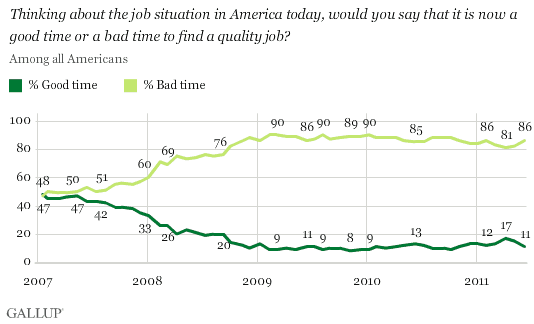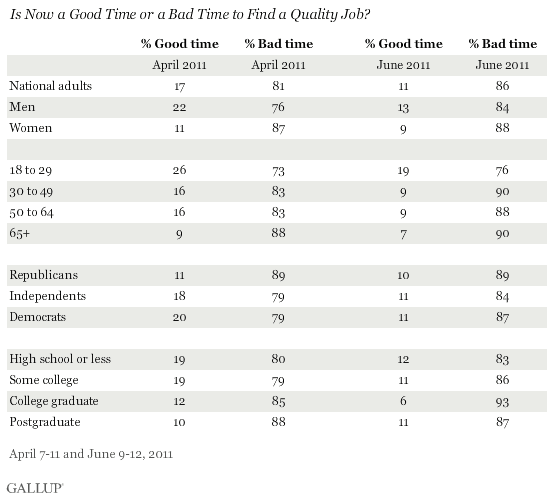PRINCETON, NJ -- Americans' assessments of the job market have soured in June after showing modest improvement in the spring, with 86% saying now is a "bad time" to find a quality job. This ties February's reading for the worst of 2011. Eleven percent say now is a "good time" to find a quality job.

Americans gave their most upbeat 2011 measure of job market conditions in April, when 81% rated it a bad time and 17% a good time to find a quality job.
���۴�ýhas asked Americans this question monthly since 2001. On several occasions in 2009 and 2010, as many as 90% of Americans rated it a bad time to find a quality job. The percentage saying it is a good time peaked in January 2007 at 48% -- prior to the recent recession.
Optimism Drops Most Among Men and Democrats
Americans' perceptions of the job situation have deteriorated across several major demographic groups between April -- the high point for the year so far -- and June.
However, the greatest deterioration in optimism has been among men, with 13% in June saying it is a good time to find a quality job, down from 22% in April. Democrats experienced a similar decline -- with optimism dropping to 11% in June from 20% in April.
College graduates show the highest percentage who are currently pessimistic about the job market, with 93% saying now is a bad time to find a quality job.

Implications
Americans' increasing negativity about now being a bad time to find a quality job is consistent with most other assessments of the current job situation. Gallup's unemployment and underemployment measures, for example, when compared with a year ago. Additionally, the government's reports show the job situation deteriorating in May.
More importantly, there is a difference between being able to get a job of any kind and finding a quality job. When the underemployment rate exceeds 18% -- meaning nearly one in five Americans are either unemployed or working part time and looking for full-time work -- just getting a full-time job is a plus. However, the current job situation is bad not only for the jobless and the underemployed, but also for those who have skills and education but can't find a quality job. That more than 9 in 10 Americans with a college degree say it is now a bad time to find a quality job underscores how difficult the job market is. The U.S. economy needs to produce many more high-quality jobs if it is going to achieve a sustainable economic recovery that benefits most Americans.
Survey Methods
Results for this ���۴�ýpoll are based on telephone interviews conducted June 9-12, 2011, with a random sample of 1,020 adults, aged 18 and older, living in the continental U.S. selected using random digit dial sampling.
For results based on the total sample of national adult, one can say with 95% confidence that the maximum margin of sampling error is ±4 percentage points.
Interviews are conducted with respondents on landline telephones and cellular phones, with interviews conducted in Spanish for respondents who are primarily Spanish-speaking. Each sample includes a minimum quota of 400 cell phone respondents and 600 landline respondents per 1,000 national adults, with additional minimum quotas among landline respondents for gender within region. Landline telephone numbers are chosen at random among listed telephone numbers. Cell phone numbers are selected using random-digit-dial methods. Landline respondents are chosen at random within each household on the basis of which member had the most recent birthday.
Samples are weighted by gender, age, race, Hispanic ethnicity, education, region, adults in the household, and phone status (cell phone only/landline only/both, cell phone mostly, and having an unlisted landline number). Demographic weighting targets are based on the March 2010 Current Population Survey figures for the aged 18 and older non-institutionalized population living in U.S. telephone households. All reported margins of sampling error include the computed design effects for weighting and sample design.
In addition to sampling error, question wording and practical difficulties in conducting surveys can introduce error or bias into the findings of public opinion polls.
View methodology, full question results, and trend data.
For more details on Gallup's polling methodology, visit .
